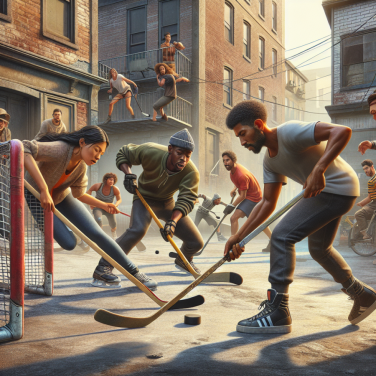From Sidewalk Sticks to Citywide Leagues: Tracing the Growth of Urban Street Hockey Community
Street hockey, often seen as the rough-and-tumble cousin of ice hockey, has long held its place in the heart of urban sports culture. Previously perceived as an impromptu activity with kids chasing a puck or ball across asphalt playgrounds and quiet suburban streets, street hockey has evolved significantly over the years. No longer confined to the shadows of its icy counterpart, this sport has grown from its humble beginnings, encapsulating the essence of urban culture and community.
The transformation of street hockey began with children using sticks and makeshift goals, crafting their own sticks from found materials, and often using anything from a tennis ball to a soda can as a puck. These improvised games were an accessible and inclusive way for enthusiasts to mimic their ice hockey idols without the need for expensive equipment or icy conditions. Games were spontaneous, energetic, and required little more than passion and creativity.
As these ad hoc gatherings became more frequent, they attracted a wider audience–a community started to form. The local popularity gave rise to more organized forms of street hockey. Community leaders and parks departments took notice, designating spaces within urban environments specifically for street hockey games. This validation was a pivotal moment, signaling the transition of street hockey from a childhood pastime to an urban sports mainstay.
Beyond informal neighborhood matches, the growth of street hockey saw the establishment of community-based leagues. These leagues solidified the sport's presence in cities, fostering a sense of camaraderie among players and spectators alike. Such organizations provided structure, with scheduled matches, official rules, and proper player equipment. They also presented opportunities for players to improve their skills, compete at various levels, and even travel to play against teams from other cities. This helped in promoting the sport across different urban landscapes.
Furthermore, street hockey started getting media attention, with local newspapers and television stations covering major tournaments and league play, further amplifying its reach. Special events and tournaments began to draw crowds, serving not just as sporting events, but also as urban gatherings that celebrated local culture and community spirit. The local street hockey victories and star players became part of urban folklore, inspiring the next generation of players.
Another significant aspect of street hockey's growth was the eventual support from professional ice hockey teams and players. Recognizing the value of street hockey in building skills and promoting the sport, many professional players participated in street hockey events or sponsored youth teams, further legitimizing the sport and providing aspirational figures for young players.
Read also:
Mastering the Greens: Tips to Elevate Your Golfing Game
Navigating Asphalt Arenas: The Evolution of Street Hockey
Street hockey, commonly referred to as ball hockey or dek hockey when played without skates, has evolved into a formidable urban pastime from its spontaneous and humble beginnings. It encapsulates the spirit of innovation, adapting the icy rinks of traditional hockey to the asphalt jungles of metropolitan landscapes. This evolution has not only widened the accessibility of the sport but also cultivated a unique subculture deeply rooted in the character and rhythm of city life.
In the latter half of the 20th century, street hockey began to gain traction as makeshift games popped up in quiet suburban streets and city alleyways. Neighborhood kids, armed with wooden sticks and whatever could serve as a makeshift puck, spent endless hours emulating their ice hockey heroes. These self-regulated matches laid the groundwork for what would become a robust and structured network of players, teams, and leagues.
As the popularity of street hockey surged, the sport developed its own set of equipment and rules. Manufacturers started producing balls designed specifically for asphalt play, which could withstand the rough surface and varied temperatures. Sticks were tailored for durability and performance outside the ice rink. Additionally, specialized protective gear emerged, providing safety without the bulkiness of traditional ice hockey equipment, allowing for the fast-paced, agile gameplay that street hockey is known for.
The sport experienced a cultural boon in the 1990s, in part due to the National Hockey League's expansion into warmer climates where ice rinks were scarce. This period saw the NHL endorse street hockey as a means to grow interest in hockey overall. The proliferation of organized leagues and the introduction of professional-grade goals and boards marked the sport's migration from a casual pastime to an organized sport with regional and national tournaments attracting significant attention.
Urban architecture has played an integral role in shaping the game. Players learned to navigate the obstacles of their environment, turning parking lots, playgrounds, and dead-end streets into arenas. The characteristics of each playing surface added unique challenges, with cracks in the pavement or uneven terrain influencing the tactics and skill sets of the players.
This gritty, urban style of play has engendered a vibrant street hockey culture that celebrates community and diversity. Players from various backgrounds come together, unified by their passion for the game, fostering an atmosphere of camaraderie and inclusion. Street hockey has become a conduit for social interaction and a platform for local and often underrepresented talents to shine.




